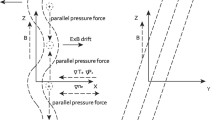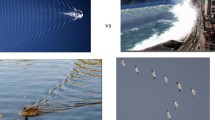Abstract
Three-dimensional numerical simulations were used to study the dependence of maximum energy of ions (protons) accelerated from low-density targets on the duration of the accelerating femtosecond laser pulse at its given total energy which, in particular, is important due to the latest achievements in the so-called postcompression of laser pulses to very short durations. It was shown that an optimum pulse length exists, which leads to maximum proton energy acquired in the regime of their maximum efficient synchronized acceleration by the “slow light” (A. V. Brantov et al., Phys. Rev. Lett. 116, 085004 (2016) [1]) and that the ultra shortening of the laser pulse does not lead to the increase in the maximum ion energy despite the increased intensity of laser light.






Similar content being viewed by others
REFERENCES
A. V. Brantov, E. A. Govras, V. F. Kovalev, and V. Yu. Bychenkov, Phys. Rev. Lett. 116, 085004 (2016). https://doi.org/10.1103/PhysRevLett.116.085004
V. Yu. Bychenkov, V. T. Tikhonchuk, and S. V. Tolokonnikov, J. Exp. Theor. Phys. 88, 1137 (1999).
C. Labaune, C. Baccou, V. Yahia, C. Neuville, and J. Rafelski, Sci. Rep. 6, 21202 (2016).
L. Willingale, G. M. Petrov, A. Maksimchuk, J. Davis, R. R. Freeman, A. S. Joglekar, T. Matsuoka, C. D. Murphy, V. M. Ovchinnikov, A. G. R. Thomas, L. Van Woerkom, and K. Krushelnick, Phys. Plasmas 18, 083106 (2011).
M. Roth, D. Jung, K. Falk, N. Guler, O. Deppert, M. Devlin, A. Favalli, J. Fernandez, D. Gautier, M. Geissel, R. Haight, C. E. Hamilton, B. M. Hegelich, R. P. Johnson, F. Merrill, et al., Phys. Rev. Lett. 110, 044802 (2013).
S. V. Bulanov and V. S. Khoroshkov, Plasma Phys. Rep. 28, 453 (2002).
U. Linz and J. Alonso, Phys. Rev. Accel. Beams 19, 124802 (2016).
K. Nemoto, A. Maksimchuk, S. Banerjee, K. Flippo, G. Mourou, D. Umstadter, and V. Yu. Bychenkov, Appl. Phys. Lett. 78, 595 (2001).
V. Yu. Bychenkov, A. V. Brantov, and G. Mourou, Laser Part. Beams 32, 605 (2014).
M. Borghesi, A. Schiavi, D. H. Campbell, M. G. Haines, O. Willi, A. J. MacKinnon, L. A. Gizzi, M. Galimberti, R. J. Clarke, and H. Ruhl, Plasma Phys. Control. Fusion 43, A267 (2001).
J. A. Cobble, R. P. Johnson, T. E. Cowan, N. Renard-Le Galloudec, and M. Allen, J. Appl. Phys. 92, 1775 (2002).
H.-S. Park, D. D. Ryutov, J. S. Ross, N. L. Kugland, S. H. Glenzer, C. Plechaty, S. M. Pollaine, B. A. Remington, A. Spitkovsky, L. Gargate, G. Gregori, A. Bell, C. Murphy, Y. Sakawa, Y. Kuramitsu, et al., High Energy Density Phys. 8, 38 (2012).
S. Yu. Mironov, J. A. Wheeler, E. A. Khazanov, and G. A. Mourou, Opt. Lett. 46, 4570 (2021). https://doi.org/10.1364/OL.438154
V. Ginzburg, I. Yakovlev, A. Kochetkov, A. Kuzmin, S. Mironov, I. Shaikin, A. Shaykin, and E. Khazanov, Opt. Express 29, 28297 (2021). https://doi.org/10.1364/OE.434216
A. V. Brantov and V. Yu. Bychenkov, Phys. Plasmas 28, 063106 (2021). https://doi.org/10.1063/5.0048024
V. Yu. Bychenkov, E. A. Govras, and A. V. Brantov, JETP Lett. 104, 618 (2016). https://doi.org/10.1134/S0021364016210086
C. D. Decker, W. B. Mori, K.-C. Tzeng, and T. Katsouleas, Phys. Plasmas 3, 2047 (1996).
V. Yu. Bychenkov, M. G. Lobok, V. F. Kovalev, and A. V. Brantov, Plasma Phys. Control. Fusion 61, 124004 (2019). https://doi.org/10.1088/1361-6587/ab5142
A. V. Brantov, E. A. Obraztsova, A. L. Chuvilin, E. D. Obraztsova, and V. Yu. Bychenkov, Phys. Rev. Accel. Beams 20, 061301 (2017). https://doi.org/10.1103/PhysRevAccelBeams.20.061301
S. C. Wilks, A. B. Langdon, T. E. Cowan, M. Roth, M. Singh, S. Hatchett, M. H. Key, D. Pennington, A. MacKinnon, and R. A. Snavely, Phys. Plasmas 8, 542 (2001).
Funding
This work was supported by the Russian Foundation for Basic Research under the RFBR–ROSATOM grant no. 20-21-00023.
Author information
Authors and Affiliations
Corresponding author
Ethics declarations
The authors declare no conflict of interest.
Additional information
Translated by E. Voronova
Rights and permissions
About this article
Cite this article
Brantov, A.V., Bychenkov, V.Y. Dependence on Laser Pulse Duration of the Maximum Energy of Protons Accelerated by Intense “Slow Light”. Plasma Phys. Rep. 48, 585–590 (2022). https://doi.org/10.1134/S1063780X22700192
Received:
Revised:
Accepted:
Published:
Issue Date:
DOI: https://doi.org/10.1134/S1063780X22700192




